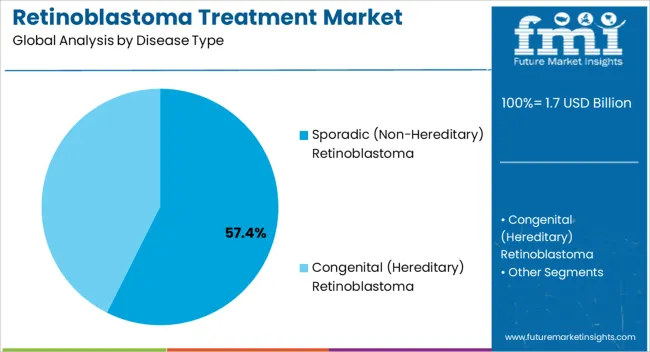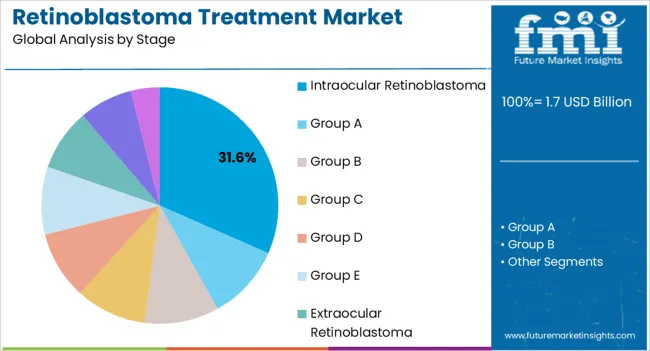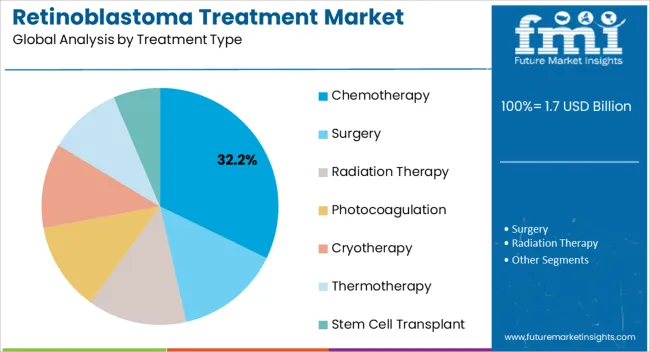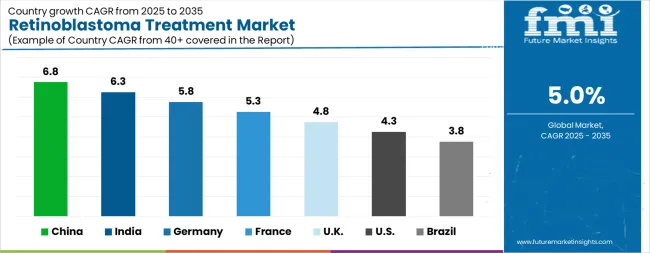The Retinoblastoma Treatment Market is estimated to be valued at USD 1.7 billion in 2025 and is projected to reach USD 2.7 billion by 2035, registering a compound annual growth rate (CAGR) of 5.0% over the forecast period.
| Metric | Value |
|---|---|
| Retinoblastoma Treatment Market Estimated Value in (2025 E) | USD 1.7 billion |
| Retinoblastoma Treatment Market Forecast Value in (2035 F) | USD 2.7 billion |
| Forecast CAGR (2025 to 2035) | 5.0% |
The Retinoblastoma Treatment market is experiencing consistent growth, driven by the rising prevalence of retinoblastoma, particularly in children under five years of age, and the growing focus on early detection and effective therapeutic interventions. Increasing awareness among healthcare providers and parents regarding the importance of timely diagnosis is driving demand for advanced treatment options. Technological advancements in imaging, surgical techniques, and targeted therapies are enabling improved treatment outcomes and reduced side effects.
Investments in pediatric oncology centers and research into precision medicine approaches are further supporting market expansion. Rising government and private sector initiatives for childhood cancer management are increasing accessibility to therapies across developed and emerging regions. The integration of multidisciplinary care, combining surgical, pharmacological, and localized therapies, is enhancing treatment efficacy.
As clinical trials continue to validate newer therapeutic modalities, and regulatory approvals for innovative drugs increase, the market is positioned for sustained growth Continued emphasis on patient-specific treatment planning, coupled with advancements in chemotherapeutic and localized therapies, is expected to reinforce the market trajectory over the next decade.
The retinoblastoma treatment market is segmented by disease type, stage, treatment type, distribution channel, and geographic regions. By disease type, retinoblastoma treatment market is divided into Sporadic (Non-Hereditary) Retinoblastoma and Congenital (Hereditary) Retinoblastoma. In terms of stage, retinoblastoma treatment market is classified into Intraocular Retinoblastoma, Group A, Group B, Group C, Group D, Group E, Extraocular Retinoblastoma, Orbital Retinoblastomas, and Metastatic Retinoblastomas. Based on treatment type, retinoblastoma treatment market is segmented into Chemotherapy, Surgery, Radiation Therapy, Photocoagulation, Cryotherapy, Thermotherapy, and Stem Cell Transplant. By distribution channel, retinoblastoma treatment market is segmented into Hospitals, Cancer Institutes, and Pharmacies. Regionally, the retinoblastoma treatment industry is classified into North America, Latin America, Western Europe, Eastern Europe, Balkan & Baltic Countries, Russia & Belarus, Central Asia, East Asia, South Asia & Pacific, and the Middle East & Africa.

The sporadic non-hereditary retinoblastoma segment is projected to hold 57.4% of the market revenue in 2025, establishing it as the leading disease type. Its dominance is being driven by the higher prevalence of unilateral cases that arise spontaneously without a genetic mutation. Early detection and diagnosis of sporadic cases allow for effective intervention through localized and systemic treatment modalities.
Multidisciplinary management strategies, including surgical excision, intraocular therapies, and chemotherapy, are increasingly being applied to optimize patient outcomes. Advances in imaging techniques and molecular diagnostics are enabling precise staging and personalized treatment planning.
The ability to tailor therapy to disease presentation, while minimizing long-term ocular and systemic complications, has reinforced clinical preference for targeted interventions in sporadic cases As research into novel treatment modalities progresses, and awareness campaigns improve early identification, the sporadic non-hereditary segment is expected to maintain its leadership, supported by clinical efficacy and growing adoption of advanced pediatric oncology protocols.

The intraocular retinoblastoma stage segment is anticipated to account for 31.6% of the market revenue in 2025, making it the leading stage category. Growth in this segment is driven by the higher incidence of localized tumors confined to the eye at the time of diagnosis, which allows for targeted treatment approaches. Early-stage intraocular tumors are often treated with organ-preserving therapies, reducing the need for enucleation while maintaining visual function.
Advances in intraocular imaging, laser therapy, cryotherapy, and localized drug delivery have enhanced the precision and efficacy of treatment. The ability to closely monitor tumor response through non-invasive imaging supports treatment optimization and reduces systemic toxicity.
Increasing availability of specialized pediatric ophthalmology centers and integration of multidisciplinary care are contributing to adoption As early detection rates improve and intraocular treatment techniques advance, the intraocular segment is expected to remain the largest stage category, providing effective, vision-preserving therapeutic options.

The chemotherapy treatment type segment is projected to hold 32.2% of the market revenue in 2025, establishing it as the leading therapy category. Its growth is driven by the effectiveness of systemic and localized chemotherapeutic agents in reducing tumor size and controlling disease progression. Chemotherapy is often applied in combination with focal therapies, enabling organ preservation and improved survival rates.
Advances in drug delivery, including intra-arterial and intravitreal administration, have enhanced precision, reduced systemic toxicity, and improved patient outcomes. The ability to customize dosing schedules according to tumor burden and patient response has reinforced clinical preference for chemotherapy.
Increasing access to pediatric oncology facilities, ongoing clinical trials, and government support for childhood cancer treatment are further supporting adoption As research continues to identify novel chemotherapeutic agents and optimize combination regimens, the chemotherapy segment is expected to maintain its leadership, driven by efficacy, safety, and integration into multidisciplinary treatment protocols.
Cancer is the leading cause of death worldwide with 8.2 million cancer related deaths in 2025 estimated by World Health Organization (WHO). Retinoblastoma is a cancer that starts in the retina, the very back part of the eye. It is the most common type of eye cancer in children.
During the early stages of development, the eyes have cells called retinoblasts that divide into new cells and fill the retina. At a certain point, these cells stop dividing and develop into mature retinal cells. Rarely, something goes wrong with this process.
Instead of maturing into special cells that detect light, some retinoblasts continue to divide and grow out of control, forming a cancer known as retinoblastoma. Retinoblastoma starts with a mutation in a gene called the retinoblastoma (RB1) gene.
Depending upon the changes in RB1 gene, retinoblastomas are two types, they are congenital (hereditary) retinoblastoma and sporadic (non-hereditary) retinoblastoma. Retinoblastoma is a rare disease. 9 in 10 children suffering from retinoblastoma are cured with the existing treatments.

| Country | CAGR |
|---|---|
| China | 6.8% |
| India | 6.3% |
| Germany | 5.8% |
| France | 5.3% |
| UK | 4.8% |
| USA | 4.3% |
| Brazil | 3.8% |
The Retinoblastoma Treatment Market is expected to register a CAGR of 5.0% during the forecast period, exhibiting varied country level momentum. China leads with the highest CAGR of 6.8%, followed by India at 6.3%. Developed markets such as Germany, France, and the UK continue to expand steadily, while the USA is likely to grow at consistent rates. Brazil posts the lowest CAGR at 3.8%, yet still underscores a broadly positive trajectory for the global Retinoblastoma Treatment Market. In 2024, Germany held a dominant revenue in the Western Europe market and is expected to grow with a CAGR of 5.8%. The USA Retinoblastoma Treatment Market is estimated to be valued at USD 585.1 million in 2025 and is anticipated to reach a valuation of USD 887.2 million by 2035. Sales are projected to rise at a CAGR of 4.3% over the forecast period between 2025 and 2035. While Japan and South Korea markets are estimated to be valued at USD 89.1 million and USD 53.9 million respectively in 2025.
| Item | Value |
|---|---|
| Quantitative Units | USD 1.7 Billion |
| Disease Type | Sporadic (Non-Hereditary) Retinoblastoma and Congenital (Hereditary) Retinoblastoma |
| Stage | Intraocular Retinoblastoma, Group A, Group B, Group C, Group D, Group E, Extraocular Retinoblastoma, Orbital Retinoblastomas, and Metastatic Retinoblastomas |
| Treatment Type | Chemotherapy, Surgery, Radiation Therapy, Photocoagulation, Cryotherapy, Thermotherapy, and Stem Cell Transplant |
| Distribution Channel | Hospitals, Cancer Institutes, and Pharmacies |
| Regions Covered | North America, Europe, Asia-Pacific, Latin America, Middle East & Africa |
| Country Covered | United States, Canada, Germany, France, United Kingdom, China, Japan, India, Brazil, South Africa |
| Key Companies Profiled | Novartis, Pfizer, Johnson & Johnson, Merck & Co., GlaxoSmithKline, Bristol-Myers Squibb Company, Teva Pharmaceutical Industries, Baxter International, Cadila Pharmaceuticals, Cellceutix Corporation, Theriva Biologics, and Advancium Health |
The global retinoblastoma treatment market is estimated to be valued at USD 1.7 billion in 2025.
The market size for the retinoblastoma treatment market is projected to reach USD 2.7 billion by 2035.
The retinoblastoma treatment market is expected to grow at a 5.0% CAGR between 2025 and 2035.
The key product types in retinoblastoma treatment market are sporadic (non-hereditary) retinoblastoma and congenital (hereditary) retinoblastoma.
In terms of stage, intraocular retinoblastoma segment to command 31.6% share in the retinoblastoma treatment market in 2025.






Full Research Suite comprises of:
Market outlook & trends analysis
Interviews & case studies
Strategic recommendations
Vendor profiles & capabilities analysis
5-year forecasts
8 regions and 60+ country-level data splits
Market segment data splits
12 months of continuous data updates
DELIVERED AS:
PDF EXCEL ONLINE
Treatment-Resistant Hypertension Management Market Size and Share Forecast Outlook 2025 to 2035
Treatment-Resistant Depression Treatment Market Size and Share Forecast Outlook 2025 to 2035
Treatment Pumps Market Insights Growth & Demand Forecast 2025 to 2035
Pretreatment Coatings Market Size and Share Forecast Outlook 2025 to 2035
Air Treatment Ozone Generator Market Size and Share Forecast Outlook 2025 to 2035
CNS Treatment and Therapy Market Insights - Trends & Growth Forecast 2025 to 2035
Seed Treatment Materials Market Size and Share Forecast Outlook 2025 to 2035
Acne Treatment Solutions Market Size and Share Forecast Outlook 2025 to 2035
Scar Treatment Market Overview - Growth & Demand Forecast 2025 to 2035
Soil Treatment Chemicals Market
Water Treatment Chemical Market Size and Share Forecast Outlook 2025 to 2035
Algae Treatment Chemical Market Forecast and Outlook 2025 to 2035
Water Treatment Market Size and Share Forecast Outlook 2025 to 2035
Water Treatment Ozone Generator Market Size and Share Forecast Outlook 2025 to 2035
Water Treatment Equipment Market Size and Share Forecast Outlook 2025 to 2035
Burns Treatment Market Overview – Growth, Demand & Forecast 2025 to 2035
CRBSI Treatment Market Insights - Growth, Trends & Forecast 2025 to 2035
Water Treatment Polymers Market Growth & Demand 2025 to 2035
Water Treatment System Market Growth - Trends & Forecast 2025 to 2035
Asthma Treatment Market Forecast and Outlook 2025 to 2035

Thank you!
You will receive an email from our Business Development Manager. Please be sure to check your SPAM/JUNK folder too.
Chat With
MaRIA